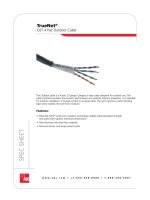Tài liệu Classes pdf
Bạn đang xem bản rút gọn của tài liệu. Xem và tải ngay bản đầy đủ của tài liệu tại đây (11.76 KB, 2 trang )
[ Team LiB ]
A.2 Classes
C# uses the class statement along with opening and closing braces, { }, to indicate the
beginning and end of a class definition. For example:
public class DataException : SystemException {
// Member definitions
}
In VB, a class definition is indicated by the Class... End Class construct:
Public Class DataException
Inherits SystemException
' member definitions
End Class
In addition, C# classes can be marked as abstract or sealed; these correspond to the VB
MustInherit and NonInheritable keywords, as shown in Table A-2
.
Table A-2. C# and equivalent VB class modifiers
C# keyword VB keyword
abstract MustInherit
sealed NonInheritable
C# uses the colon to indicate either inheritance or interface implementation. Both the
base class and the implemented interfaces are part of the class statement. For example:
public class DataSet : MarshalByValueComponent, IListSource,
ISupportInitialize, ISerializable
In VB, the base class and any implemented interfaces are specified on separate lines
immediately following the Class statement. A class's base class is indicated by preceding
its name with the Inherits keyword; any implemented interfaces are indicated by the
Implements keyword. Hence, the previous definition of the DataSet class in C# would
appear as follows in VB:
Public Class DataSet
Inherits MarshalByValueComponent
Implements IListSource, ISupportInitalize, ISerializable
[ Team LiB ]









